
Flexible Fuel Vehicles- 1993-1995 Dodge Spirit & Plymouth Acclaim

In 1993 Chrysler introduced a engine for use in flexible fuel vehicles- A port fuel injected non-turbo 2.5 that ran on a combination of methanol and gasoline (called M85 because it was 85% methanol) OR due to the limited distribution and availability of M85 just plain regular gas so you didn't get stranded out in the middle of nowhere without a methanol pump in sight. There was a sensor at the gas tank that could detect where the gas/methanol ratio was at and adjust the spark & fuel curves accordingly. By running the engine on M85, smog-forming emissions were reduced 30-50% and toxic emission were reduced 50%. Most of the 1993 FFV cars seem to end up in government (4500 units) fleets but I understand in 1993-1995 anyone could buy one at the dealer. FFV 2.5 Spirits & Acclaims can be identified by the letter "V" as the eighth digit in the vin number.
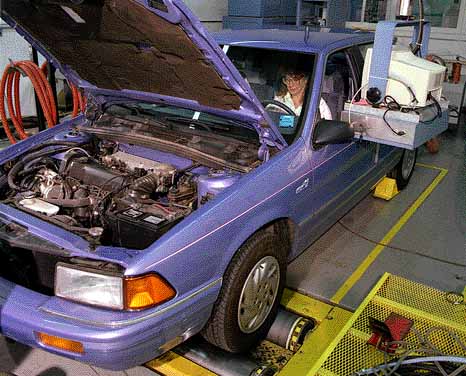
FFV Spirit undergoing dyno & emission testing
M85 vehicles have a few problems... Number one among them is that M85 is highly corrosive! All the fuel system parts had to be rated for use with methanol and so was constructed with stainless steel! (The injectors are nickel plated internally) Also engine clearances were different and special engine oil was specified for use with M85 as well. Anything that could come in contact with methanol had to be tested and upgraded, even the valve guide seals are different! All methanol specific parts are tagged or painted green.
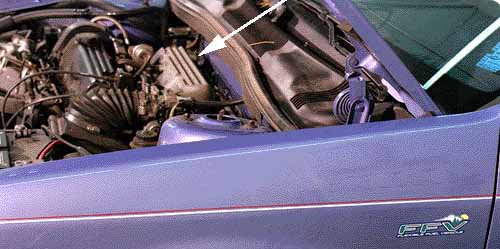
Notice the Turbo intake manifold.
The real kick in the pants was that methanol has about half the energy of gasoline (but can be made from many sources like coal, natural gas or agricultural waste) which means you get worse gas mileage! Horsepower wise the difference was slight, just a few more hp and ft/lbs of torque.
The Flex Fuel Vehicle setup is a perfect example of parts bin engineering- Take a 2.5 TBI engine, install a Turbo I intake manifold, distributor & recalibrated SBEC II, use a air cleaner off the Mexican spec PFI non-turbo engine and mix well.
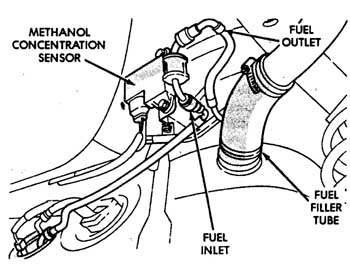
The only really "new" part (besides all the stuff that had to be changed because it comes in contact with methanol, see below) was the methanol blend sensor that resides at the rear of the car that tells the computer what the blend of gas/methanol is.
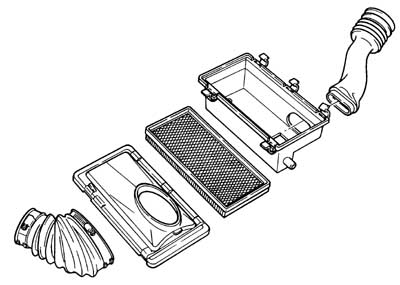
Air filter housing from Mexican PFI non-turbo application
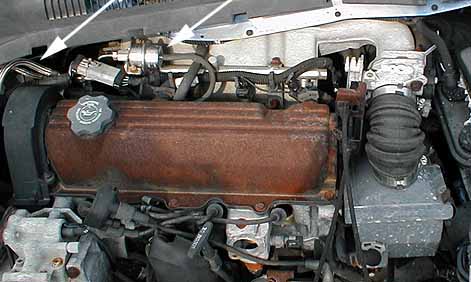
Notice the flexible stainless braided Teflon fuel lines and stainless fuel regulator and fuel rail.
FFV methanol specific parts-
1) Purge solenoid
2) Fuel pump
3) Tank sending unit
4) Fuel gauge
5) Fuel tank (plastic)
6) Stainless steel FP regulator and o-rings
7) Stainless steel fuel rail
8) Fuel injectors and o-rings
9) Fuel lines
10) EVAP canister
11) Fuel filler cap
12) Fuel filler tube
13) Chrome faced piston rings
14) Hi-fluorine content valve guide seals
15) Turbo spec intake valves
Flex Fuel Vehicle Calibration
Have a FFV that needs a computer? Well I don't have a computer but I do have the calibration! In theory this could be dropped into any SBEC II with the correct 4 injector driver.. Of course they might be somewhat hard to find since Chrysler stopped making Turbo SBEC's in 1992. They did make PFI non-turbo cars overseas so if you really need to get a FFV back on the road and you can find a Mexican SBEC and get the EEPROM reprogrammed. This calibration came from a wrecked FFV car from Sebrings towing and salvage in Delta PN.
The SBEC module (part number was 4686405) was smashed but the cal chip was ok and the image was extracted. The EEPROM was a Toshiba TC97208AP with a Chrysler part number 4517827. You will a Needhams based program and burner to write the chip.
1993-1995 FFV Calibration
Want to hear a humorous story
about FFV ownership? Check this out.